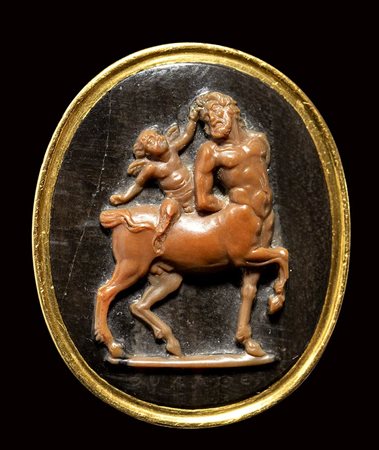 Bertolami Fine Art - Bertolami Fine Art, 1 Harewood Place 1, W1S 1BU Londra
Bertolami Fine Art - Bertolami Fine Art, 1 Harewood Place 1, W1S 1BU Londra
ASTA 107 - Glittica Sessione Unica
venerdì 22 aprile 2022 ore 15:00 (UTC +00:00)
An important signed agate cameo set in a gold ring. Centaur with Cupid. 18th century.
An important signed agate cameo set in a gold ring. Centaur with Cupid.
18th century.
This large hardstone cameo of the Centaur with Cupid (Allegory of the invincible strength of the Love) is engraved by Ludwig Friederich Walther (1757-1817), with his signature in Greek. The stone is mounted in a Georgian gold ring, c. 1780. Missing on the figure and a crack in the stone. This cameo can be identified as a gem which was commissioned by «the equerry von Crailsheim», i.e. the baron Alexander Hannibal von Crailsheim (c. 1740-1816), chamberlain at the Brandenburg-Ansbach court, personal master of the stable of the duke, and which he had set a ring, which became before 1793 the personal ring of an important member of the Hohenzollen family, Christian Friederich Karl Alexander (1736-1806), last margrave of Beyreuth and Ansbach. The margrave was a well-known amateur of horses and of love. About the career of the gem engraver Walther, the centaur cameo is one of his few gems attested in contemporary literature, documented by 1793 as one of his masterpiece. It seems that the material used for this gem is a rare type of fossilized wood, found from 1767 onwards in Rodach - north of Coburg- and exploited by the Walther family until it was exhausted in the late 18th century, became a stone, comparable to an agate. The motif of Centaur with Cupid is copied from a 2nd century A.D. (Hadrianic) marble statue (from Borghese coll. than to Louvre coll. in Paris). This subject was engraved twice by Giovanni Pichler, the last one carved before 1782.
Stone 20 x 25 mm; ring size 17 x 18 mm; 8,46 gr.




